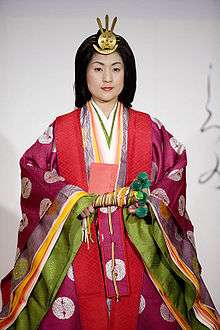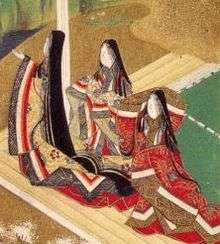Jūnihitoe



The jūnihitoe (十二単) is an extremely elegant and highly complex kimono that was only worn by court-ladies in Japan. Literally translated, it means "twelve-layer robe". The older term, still used by scholars but not widely recognised in mainstream Japan, is Karaginu Mo (唐衣裳). This is in reference to its Chinese coat (Karaginu) and apron-like train (Mo), the defining parts of the costume.
The jūnihitoe started to appear around the 10th century during the Heian Era. The various layers are silk garments. The innermost garment is made of white silk, followed by other layers which have various names, which are finally closed off by a final layer or coat. The total weight could add up to 20 kilograms.
The colours and the arrangements of the layers are very important. The colours have poetic names, such as "crimson plum of the spring". The only place where the layers are discernible is around the sleeves and the neck. The arrangements of the layers and their colours were a good indication to any outsider what taste and what rank the lady had. Apart from their robes, Japanese court ladies also wore their hair very long, only cut at the sides of their faces in a layered fashion; the longer hair was sometimes worn tied back.
An important accessory was an elaborate fan, which could be tied together by a rope when folded. This was used by the lady not only to cool herself, since it could get very hot, but it was also an important communication device. Since a lady was not allowed to speak face-to-face to a male outsider, she could hold her sleeve up or use her opened fan to shield herself from inquiring looks. Communication to a suitor had to follow with her normally hiding behind the sudare (screen or blinds) in any case. The suitor could only see the sleeves of her jūnihitoe that were peeking underneath the blinds. This practice was prominent during the Heian-Era, being frequently and accurately described in the Tale of Genji (jp: Genji monogatari).
The movement in such a robe could be difficult due to its weight. Ladies actually slept in their jūnihitoe sometimes, using it as a form of pajamas. Layers could be shed or kept, depending on the season and the night temperatures. During the Muromachi-Era, however, the dress was sometimes reduced to five robes (known as a "five-layer robe").
Contemporary use
Today, the jūnihitoe can only be seen in museums, movies, costume demonstrations, tourist attractions or at certain festivals. These robes are one of the most expensive items of Japanese clothing. Only the Imperial Household still officially uses them at some important functions. Women such as an empress or princess wear a jūnihitoe, while men such as the Emperor or a prince wear a sokutai. During the wedding of Masako, Crown Princess of Japan to the crown prince, she wore a jūnihitoe for the official ceremony. The jūnihitoe was also worn by Empress Michiko during the enthronement ceremony of Emperor Akihito in 1990. Her ladies-in-waiting were all wearing the jūnihitoe; however, in modified form from the Edo period, not the Heian style.
The Saiō Matsuri Saiō Festival is held every in Meiwa, Mie and showcases Heian era dresses. They are also featured at the Aoi Matsuri in Kyoto.
The Layers of the jūnihitoe
The layers of the Jūnihitoe consist of:[1]
- The undergarments: Usually a two-piece cotton or silk garment.
- Kosode: A short silk red or white robe of ankle or lower calf length.
- Nagabakama: A very long red pleated split skirt which can also be worn by men.
- Hitoe: An unlined silk robe; usually red, white or blue-green, although other colors (such as dark red-violet or dark green) very rarely occur.
- Uchigi: A series of brightly coloured unlined robes which create a layered effect.
- Uchiginu: A beaten scarlet silk robe worn as a stiffener and support for the outer robes.
- Uwagi: A patterned woven and decorated silk robe than is shorter and narrower than the Uchiginu.
- Kouchigi: (lit., "small cloak") a shorter brocade robe worn over the uchigi or uwagi to add some formality on occasions when the karaginu and mo were NOT worn; (img)
- Karaginu: A waist length Chinese style jacket.
- "Mo": An apron-like train, down the back of the robe. White with painted/embroidered adornment.
References
Notes
- There is a Japanese band of the same name (see 12. Hitoe).
External links
![]() Media related to Jūnihitoe at Wikimedia Commons
Media related to Jūnihitoe at Wikimedia Commons
- The Costume Museum | The Heian Period
- Images of a jūnihitoe
- Encyclopaedia Britannica: Juni Hitoe
- Gallery of Junihitoe Images
- Reference Chart of Juunihitoe Color Schemes (note: incomplete with some translation errors, but includes uwagi and karaginu colors)
- Reference Chart of Juunihitoe Color Schemes (note: complete, but written in Japanese characters and without uwagi/karaginu color information)
- How a Juunihitoe is Donned (thumbnail list links)